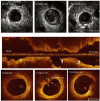Interobserver Variability of Coronary Stenosis Characterized by Coronary Angiography: A Single-Center (Toronto General Hospital) Retrospective Chart Review by Staff Cardiologists
- PMID: 39157424
- PMCID: PMC11327917
- DOI: 10.2147/VHRM.S431612
Interobserver Variability of Coronary Stenosis Characterized by Coronary Angiography: A Single-Center (Toronto General Hospital) Retrospective Chart Review by Staff Cardiologists
Abstract
Introduction: The reliability of interpretation of coronary angiography as a diagnostic tool was investigated. Furthermore, the impact of interobserver variability of coronary lesions on clinical decision-making was assessed. One of our motivations to do this research was the research gaps and our aim to have up-to-date information regarding interobserver variability among different cardiologists.
Methods: Our objective was to quantify interobserver variability among cardiologists who have seen angiograms independently. Disagreement among cardiologists in the visual assessment of invasive coronary angiography of coronary artery stenosis is not uncommon in previous studies. Three cardiologists with extensive experience in coronary angiography, including the primary cardiologist of each patient, read the angiograms of 200 patients from Toronto General Hospital independently.
Results: Our research showed the mean agreement among all participating observers was 77.4%; therefore, the interobserver variability of coronary angiography interpretation was 22.6%.
Discussion: Coronary angiography is still the gold-standard technique for guidance regarding coronary lesions. Sometimes, coronary angiography results in underestimation or overestimation of a lesion's functional severity. Interobserver variability should also be considered when interpreting the severity of coronary stenoses via invasive coronary angiography. This research shows that interobserver variability regarding coronary angiograms is still present (22.6%).
Keywords: ICA; PCI; coronary angiography; fractional flow reserve; interobserver variability.
Plain language summary
Plain language summary: The gold-standard method for diagnosing coronary stenosis, invasive coronary angiography has some challenges too. One of these challenges has been the difference among various cardiologists regarding determination of severity of each coronary stenosis. In this study, we focused on differences in interobserver variability in coronary angiography interpretation. Three cardiologists who were experienced in coronary angiography read each patient’s coronary angiogram separately. Overall, 200 patients with a history of angiography at Toronto General Hospital were selected randomly. The research showed that overall agreement among all participating cardiologists with regard to the reading of coronary angiograms was 77.4%. In other words, interobserver variability of 22.6% was seen among the readers.
© 2024 Shivaie et al.
Conflict of interest statement
The authors report no conflicts of interests for this work.
Figures
Similar articles
-
Influence of operator expertise and coronary luminal segmentation technique on diagnostic performance, precision and reproducibility of reduced-order CT-derived fractional flow reserve technique.J Cardiovasc Comput Tomogr. 2020 Jul-Aug;14(4):356-362. doi: 10.1016/j.jcct.2019.11.014. Epub 2019 Nov 26. J Cardiovasc Comput Tomogr. 2020. PMID: 31787591
-
How good are experienced interventional cardiologists at predicting the functional significance of intermediate or equivocal left main coronary artery stenoses?Int J Cardiol. 2007 Aug 21;120(2):254-61. doi: 10.1016/j.ijcard.2006.11.220. Epub 2007 Mar 7. Int J Cardiol. 2007. PMID: 17346818
-
Coronary computed tomographic angiography in patients suspected of coronary artery disease: impact of observer experience on diagnostic performance and interobserver reproducibility.J Cardiovasc Comput Tomogr. 2010 May-Jun;4(3):186-94. doi: 10.1016/j.jcct.2010.03.010. Epub 2010 Mar 31. J Cardiovasc Comput Tomogr. 2010. PMID: 20451487
-
A practical guide to reading CT coronary angiograms--how to avoid mistakes when assessing for coronary stenoses.Int J Cardiovasc Imaging. 2007 Oct;23(5):617-33. doi: 10.1007/s10554-006-9173-9. Epub 2006 Dec 21. Int J Cardiovasc Imaging. 2007. PMID: 17186138 Review.
-
Non-invasive imaging software to assess the functional significance of coronary stenoses: a systematic review and economic evaluation.Health Technol Assess. 2021 Sep;25(56):1-230. doi: 10.3310/hta25560. Health Technol Assess. 2021. PMID: 34588097
Cited by
-
Cross-institutional validation of a polar map-free 3D deep learning model for obstructive coronary artery disease prediction using myocardial perfusion imaging: insights into generalizability and bias.Eur J Nucl Med Mol Imaging. 2025 Apr 8. doi: 10.1007/s00259-025-07243-w. Online ahead of print. Eur J Nucl Med Mol Imaging. 2025. PMID: 40198356
References
-
- Mortality GBD. & causes of death, C. global, regional, and national age-sex specific all-cause and cause-specific mortality for 240 causes of death, 1990–2013: a systematic analysis for the Global burden of disease study 2013. Lancet. 2015;385:117–171. doi:10.1016/S0140-6736(14)61682-2 - DOI - PMC - PubMed
-
- Clinical Anatomy. Richard S S. 2012. ninth edition. 387:1.
MeSH terms
LinkOut - more resources
Full Text Sources
Miscellaneous




